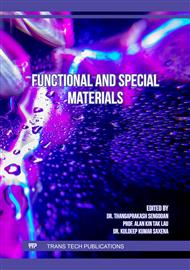[1]
Swain, P. K., Das Mohapatra, K., & Swain, P. K. (2020). Optimization, error analysis, and mathematical modeling of Al-SiCp metal matrix nanocomposites using coated carbide insert. Materials Today: Proceedings, 26, 620–631
DOI: 10.1016/j.matpr.2019.11.334
Google Scholar
[2]
Rajkumar, G., Balasundaram, R., Ganesh, N., & Rajaram, S. (2018). Investigation of turning parameters of machining Inconel 718 using titanium and Carbide inserts. Materials Today: Proceedings, 5(5), 11283–11294
DOI: 10.1016/j.matpr.2018.02.095
Google Scholar
[3]
Mishra, S. K., Ghosh, S., & Aravindan, S. (2019). Performance of laser processed carbide tools for machining of ti6al4v alloys: A combined study on experimental and Finite Element Analysis. Precision Engineering, 56, 370–385
DOI: 10.1016/j.precisioneng.2019.01.006
Google Scholar
[4]
Devillez, A., Schneider, F., Dominiak, S., Dudzinski, D., & Larrouquere, D. (2007). Cutting forces and wear in dry machining of Inconel 718 with coated carbide tools. Wear, 262(7-8), 931–942
DOI: 10.1016/j.wear.2006.10.009
Google Scholar
[5]
Swain, N., Venkatesh, V., Kumar, P., Srinivas, G., Ravishankar, S., & Barshilia, H. C. (2017). An experimental investigation on the machining characteristics of nimonic 75 using uncoated and TiAlN coated tungsten carbide micro-end mills. CIRP Journal of Manufacturing Science and Technology, 16, 34–42
DOI: 10.1016/j.cirpj.2016.07.005
Google Scholar
[6]
Grzesik, W., Rech, J., Żak, K., & Claudin, C. (2009). Machining performance of pearlitic–ferritic nodular cast iron with coated carbide and silicon nitride ceramic tools. International Journal of Machine Tools and Manufacture, 49(2), 125–133
DOI: 10.1016/j.ijmachtools.2008.10.003
Google Scholar
[7]
Sen, B., Gupta, M. K., Mia, M., Mandal, U. K., & Mondal, S. P. (2020). Wear behaviour of TiAlN coated solid carbide end-mill under alumina enriched minimum quantity palm oil-based lubricating condition. Tribology International, 148, 106310
DOI: 10.1016/j.triboint.2020.106310
Google Scholar
[8]
Bushlya, V., Johansson, D., Lenrick, F., Ståhl, J.-E., & Schultheiss, F. (2017). Wear mechanisms of uncoated and coated cemented carbide tools in machining lead-free Silicon Brass. Wear, 376-377, 143–151
DOI: 10.1016/j.wear.2017.01.039
Google Scholar
[9]
Kene, A. P., Orra, K., & Choudhury, S. K. (2016). Experimental investigation of tool wear behavior of multi-layered coated carbide inserts using various sensors in hard turning process. IFAC-PapersOnLine, 49(12), 180–184
DOI: 10.1016/j.ifacol.2016.07.592
Google Scholar
[10]
Zhao, J., & Liu, Z. (2020). Influences of coating thickness on cutting temperature for dry hard turning inconel 718 with PVD TiAlN coated carbide tools in initial tool wear stage. Journal of Manufacturing Processes, 56, 1155–1165
DOI: 10.1016/j.jmapro.2020.06.010
Google Scholar
[11]
Sahoo, A. K., & Sahoo, B. (2012). Experimental investigations on machinability aspects in finish hard turning of Aisi 4340 steel using uncoated and multilayer coated carbide inserts. Measurement, 45(8), 2153–2165
DOI: 10.1016/j.measurement.2012.05.015
Google Scholar
[12]
Kurniawan, R., Park, G. C., Park, K. M., Zhen, Y., Kwak, Y. I., Kim, M. C., Lee, J. M., Ko, T. J., & Park, C.-S. (2020). Machinability of modified Inconel 713C using a WC TiAlN-coated tool. Journal of Manufacturing Processes, 57, 409–430
DOI: 10.1016/j.jmapro.2020.06.032
Google Scholar
[13]
Sahin, Y., & Motorcu, A. R. (2005). Surface roughness model for machining mild steel with coated carbide tool. Materials & Design, 26(4), 321–326
DOI: 10.1016/j.matdes.2004.06.015
Google Scholar
[14]
Alagarsamy, S. V., Ravichandran, M., Meignanamoorthy, M., Chanakyan, C., Dinesh Kumar, S., & Sakthivelu, S. (2020). Influence of CNC turning variables on high strength beryllium-copper (c17200) alloy using tungsten carbide insert. Materials Today: Proceedings, 27, 925–930
DOI: 10.1016/j.matpr.2020.01.260
Google Scholar
[15]
Shankar, N. V. S., Ravi Shankar, H., Pavan Kumar, N., & Saichandu, K. (2020). Process parameter optimization for minimizing vibrations and surface roughness during turning en19 steel using coated carbide tool. Materials Today: Proceedings, 24, 788–797
DOI: 10.1016/j.matpr.2020.04.387
Google Scholar
[16]
Radha Krishnan, B., & Ramesh, M. (2020). Optimization of machining process parameters in CNC turning process of IS2062 E250 steel using coated carbide cutting tool. Materials Today: Proceedings, 21, 346–350
DOI: 10.1016/j.matpr.2019.05.460
Google Scholar
[17]
Haja Syeddu Masooth, P., Jayakumar, V., & Bharathiraja, G. (2020). Experimental investigation on surface roughness in CNC end milling process by uncoated and TiAlN coated carbide end mill under dry conditions. Materials Today: Proceedings, 22, 726–736
DOI: 10.1016/j.matpr.2019.10.036
Google Scholar
[18]
Verma, M., & Pradhan, S. K. (2020). Experimental and numerical investigations in CNC turning for different combinations of tool inserts and workpiece material. Materials Today: Proceedings, 27, 2736–2743
DOI: 10.1016/j.matpr.2019.12.193
Google Scholar
[19]
Günay, M., Korkmaz, M. E., & Yaşar, N. (2020). Performance analysis of coated carbide tool in turning of Nimonic 80a superalloy under different cutting environments. Journal of Manufacturing Processes, 56, 678–687
DOI: 10.1016/j.jmapro.2020.05.031
Google Scholar
[20]
Kumari, S., Sonia, P., Singh, B., Abhishek, K., & Saxena, K. K. (2020). Optimization of surface roughness in EDM of pure magnesium (Mg) using TLBO. Materials Today: Proceedings, 26, 2458–2461
DOI: 10.1016/j.matpr.2020.02.523
Google Scholar
[21]
Sonia, P., Jain, J. K., & Saxena, K. K. (2020). Influence of severe metal forming processes on microstructure and mechanical properties of MG Alloys. Advances in Materials and Processing Technologies, 1–24
DOI: 10.1080/2374068x.2020.1802554
Google Scholar
[22]
Bandhu, D., Kumari, S., Prajapati, V., Saxena, K. K., & Abhishek, K. (2020). Experimental Investigation and Optimization of RMDtm welding parameters for ASTM A387 grade 11 steel. Materials and Manufacturing Processes, 36(13), 1524–1534
DOI: 10.1080/10426914.2020.1854472
Google Scholar
[23]
Das, L., Nayak, R., Saxena, K. K., Nanda, J., Jena, S. P., Behera, A., Sehgal, S., Prakash, C., Dixit, S., & Abdul-Zahra, D. S. (2022). Determination of optimum machining parameters for face milling process of Ti6a14v metal matrix composite. Materials, 15(14), 4765
DOI: 10.3390/ma15144765
Google Scholar
[24]
Sonia, P., Jain, J. K., & Saxena, K. K. (2021). Influence of ultrasonic vibration assistance in manufacturing processes: A Review. Materials and Manufacturing Processes, 36(13), 1451–1475
DOI: 10.1080/10426914.2021.1914843
Google Scholar


